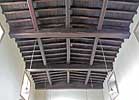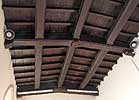For this church:    |
|
 North arcade and aisle North arcade and aisle |
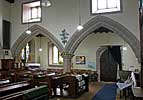 South arcade and aisle South arcade and aisle |
The fabric of the nave and chancel are 13th century with the two bay arcades being later additions (Billson). On the north and west side of the clerestory are two 16th century style double lancet windows with hood moulds. The nave is divided from each aisle by two pointed arches with octagonal pillars with moulded octagonal capitals. The south aisle is original 14th century with a 15th century style triple lancet window with square head similar to the two windows in the north aisle. The east end of the south aisle has a double lancet window with fine geometrical tracery. At the west end of the south aisle is a 13th century style double lancet window with hood mould. The north aisle is a copy of the south and was added during the rebuilding in 1842. It has two 15th century style triple lancet windows with square heads and hood moulds. At the west end is a 14th century style double lancet window with hood moulds. Both aisles have low-pitched roofs with span beams.
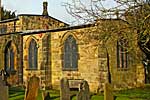 Chancel exterior from Chancel exterior from the south-east |
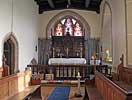 Chancel interior Chancel interiorlooking east |
In 1867 Sir Stephen Glynne described the chancel as being ‘low and open to the nave by a low pointed arch, rather acute in form and lob sided’. The east end has an untraceried cusped triple lancet window with a depressed head and hood mould; internally the large carved reredos partially obscures the window. On the north side is a moulded doorway, and in the north east corner is a monument to the Willoughby family located under a low arched recess. On the opposite side in the south east corner is a 14th century single bowl piscina. On the south side of the chancel is a two-stage buttress with two 14th century style double lancet windows with hood and mould stops on either side. On the south east and north east corners of the chancel are two, two stage buttresses. On the north side is a lean-to-vestry chamber with a double lancet window and a Tudor style arched doorway and door. The pitched roof has moulded eaves and coped parapets.
The nave and chancel each have low-pitched roofs. There are coped parapets on the east and west end of the nave and on the east end of the chancel. The roofs to the north and south aisles are also low pitched with coped parapets on the east and west ends.
 Tower from the Tower from thesouth-west |
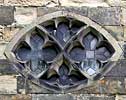 Eye-shaped window Eye-shaped windowon the west wall of the tower |
The low two-stage west tower, constructed in local ironstone, is 13th and late 14th century with chamfered plinth, stringcourse, moulded eaves and crenelated parapet. The first stage to the west has an unusual eye-shaped patterned window, that may date from the 1842 rebuilding. There is also a slit opening on the south side. The second stage has three 14th century square headed double lancets to the north, south and west, which Glynne described as ‘flamboyant tracery so common to the district’. The short octagonal spire, possibly 14th century, is stepped back and has four small gabled lucarnes and ball finial. The tower contains two bells dating from 1733.
In an arched recess within the 13th century western tower is an unidentified organ contained within a carved wooden case.
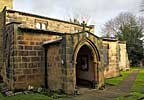 The south porch The south porch |
The south porch, described by Glynne in 1867 as being ‘new’, has a pointed doorway entrance with octagonal responds and hood mould. The roof is low pitched with a coped parapet. The inner roof has common roof rafters. The inner/main door is 14th century style.
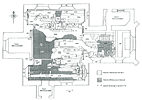 Plan of excavation Plan of excavation |
In 1999 Trent and Peak Archaeological Unit conducted an archaeological watching brief on behalf of the then incumbent of St Catherine’s, the Rev Duncan McCann and Cossall Parochial Church Council when contractors excavated the floors of the nave, north and south aisles and part of the chancel prior to relaying new floors. During excavations the entrance to the Willoughby vault became exposed, requiring the permission of Lord Middleton to allow the largely unknown contents to be recorded without disturbing the remains. A report, written by Lee Elliott, Project Supervisor, from which the following edited extracts have been taken, provides valuable information about the medieval church largely hidden by the rebuilding of 1842, together with the construction and contents of the Willoughby vault.
In the nave two features discovered of certain medieval date were the truncated east-west aligned linear features running below the north and south arcades. Their size and position suggest that they represent the north and south walls of the nave. Structurally the south wall predates the 14th century arcade. The north wall survived until the addition of the north aisle in the 1842 rebuilding. At the west end of the nave a circular pit, containing coal and molten lead waste, is thought to be the remains of a lead melting hearth, possibly used during repairs to the church windows or roof.
When the south aisle foundations were exposed, two courses of large rectangular sandstone blocks were found. Lying on top of these foundations were two courses of brick and ceramic tiles. Additional brick courses may be present in the wall above but have been concealed by rendering. The stone foundations and brick courses appear to be out of alignment and differ from the brick foundations of the north aisle. They could be medieval and were reused during the rebuilding of the church in 1842. If this is the case the original aisle may have been smaller as the foundations stepped out from the base of the east and west walls. Another apparent survival from the medieval south aisle was the shortened foundation consisting of three large angular sandstone blocks, packed behind with numerous smaller stones. This feature matches with the possible position of the altar to the chantry chapel known to have existed in the south aisle.
The north aisle was added to the church during the rebuilding in 1842. The foundations of the north and east walls were of brick, while those of the west wall and the north arcade pier were reused stone from earlier fabric, several of which were moulded. The west wall foundation contained randomly laid rubble. Amongst the several re-used fragments were three pieces of window mullion, while ashlar, chamfered pieces, and parts of a square headed window were present in the pier foundation. Near the centre of the north aisle a large stone slab with mortar on the under surface was exposed, together with a further slab partly exposed to the north. These were believed to be the remains of a path that once led to a door in the north wall of the nave before the construction of the north aisle.
The investigation of the chancel revealed a brick sleeper wall and along the south wall was a shallow trench with infilling and large flat angular stones. The feature appeared to be cut by the stone foundation of the present south chancel wall, separated from the base of the chancel wall by a 19th century brick flue, while to the east it terminated just before the sanctuary step. Its relationship with a possible floor layer was unclear. Although undated, and its function uncertain, it may represent the foundation of an earlier or the present chancel wall. The chancel floor was exposed up to the sanctuary step, which comprised a west face of large sub-angular stone, packed behind with smaller stones in a mortar bond forming the west wall of the Willoughby vault. Re-flooring also exposed the apparently shallow foundation of the south respond of the chancel arch.
Cut into the natural clay and sandstone in the floor of the chancel, nave and aisles were 15 graves filled with loam; only four contained remains, including two infants. It is thought that given the time span between the addition of the north aisle in 1842, and the abandonment of intramural burial following the Burial Boards Act 1852, many of the graves in this area predated its construction and were originally buried in the graveyard. The two infant burials were discovered at the east end of the south aisle cutting the foundation of the possible chapel altar. This possibly occurred sometime after the reformation following the dissolution of the chantries. Four copper alloy pins were found suggesting that a shroud or winding sheet was used; this method of burial was generally abandoned by the late 17th to early 18th century.
During the removal of the stone floor along the north wall of the chancel, a set of six stone slab steps were revealed leading 1.5m down to the floor of the Willoughby vault below the sanctuary. The vault walls measured 3.8m from north to south and 2.34m from east to west. The walls were constructed from coarsely dressed stone blocks with mortar bond, except for the south wall, which was brick.
The brick-barrel vault roof was approximately 1.3m in height, comprising of three parts; a central section 2.2m wide and two 0.8m wide north and south end sections, approximately 0.15m lower. Both end sections correspond with a large stone shelf at the south end and the entrance to the vault at the north end. A number of remains were present within the vault that were either interned, or were from burials disturbed by work in the church. Eight coffins were visible, five of lead and three of stone. Four of these were single break coffins, tapering in from the shoulder towards both the head and foot of the coffin, which were the most common from the late 17th century onwards. The fifth coffin was rectangular, the sixth was square shouldered with a head recess, the seventh was rectangular with sides tapering to the feet, and the eighth had been crushed out of shape. Some lead coffins originally had outer wooden shells, and stone coffins were set within the vault floor and sealed with stone lids.
The vault originates from the latter half of the 17th century, which coincides with the 1680 date for the coffins of George and Elizabeth Willoughby, and suggests that the vault may have been constructed for their joint internment.
Although the recording of the Willoughby vault was restricted, valuable information was gained and recorded including; its construction, the number of occupants, the founder and the date of building.
The large stone coffins of George Willoughby and Elizabeth Willoughby are inscribed on the stone lids although the inscription of George Willoughby’s is incomplete:
|
The third stone coffin, recessed into the floor of the vault with a stone lid, was inscribed with a small incised potent cross and an inscription where legible, read:
| SEP THE 1.0.1694 G W DIED |
Four of the lead coffins were located at the south end of the vault and only one had a small rectangular breastplate inscribed with the date 1685. The identity of this coffin could be that of Francis Willoughby whose birth, baptism and burial are recorded in the parish register on April 16th 1685.
With the fifth lead coffin, two unattached oval copper-alloy breastplates were found on the lid. One breastplate had possibly been attached to the fifth coffin and the other maybe from one of the unidentified coffins.
|
Lee Elliot concluded his archaeological report by highlighting the importance of the continued survival of vaults. ‘The vault provides a lasting physical presence to the family, outliving any monuments that may have existed in the church, which as is common, did not survive the rebuilding of the 19th century’.
Technical Summary
Timbers and roofs
Bellframe
Timber bellframe, Elphick type O variant, Pickford group 5.P with variant E type 2 braces, for 2 bells, with wooden headstocks, wheels and plain bearings. The frame is unusual in having queen-posts, rather than the more common king-posts; the braces are curved. The frame has been tree-ring dated to a felling date of AD 1619 with two possibly earlier timbers dating close to AD 1500 that have perhaps been reused. The report on the dendrochronological analysis of samples taken from timbers of the bellframe is available for download.
Scheduled for preservation: 1.
Walls
| NAVE | CHANCEL | TOWER | |
| Plaster covering & date | All plastered and painted | All plastered and painted | All plastered; some evidence of former red colourwash |
| Potential for wall paintings | Unlikely, unless hidden C19th stencil work (no evidence) | Unlikely, unless hidden C19th stencil work (no evidence) | Unlikely; some colourwash. |
Excavations and potential for survival of below-ground archaeology
In 2000 an archaeological watching brief was undertaken by Trent and Peak Archaeology during the relaying of the floors in the body of the church. Beneath the former floor were a number of brick sleeper walls with pit shale as infilling, these were removed to a depth of 0.45m. The surface revealed at that depth comprised deposits of natural clay and sandstone cut by several undated features, including 15 grave cuts. The truncated remains of the north and south nave wall foundations were revealed. A further stone foundation at the east end of the south aisle may represent part of a former chantry chapel altar. The existing south aisle appears to have been rebuilt on stone foundations of the original medieval aisle but the north aisle, added in 1842-3, has brick foundations with the exception of the west wall and north arcade pier which contained reused medieval material, including moulded stonework. A possible slab stone path in the north aisle may represent the position of a former north doorway. The Willoughby vault under the sanctuary was inspected - details are given the the body of the text above. Few artefacts were revealed other than in the vault, amongst which was a worked fragment of high-quality alabaster possibly from a memorial stone earlier than the C16th.
In 2021 a further monitoring programme took place for a new water pipe in the churchyard. The report indicates that no major archaeological features or stratigraphy were disturbed.
The fabric superficially dates from the C13th to the C19th but with the majority of the body of the church dating from a substantial restoration and rebuilding of 1842-3, with a tower that is of the C13th and C14th but with some elements of C19th restoration. The extent of the C19th restoration and rebuilding has obscured much medieval detail, though there is some reused material in the exterior walls, the chancel arch, and the south arcade, and it is unclear as to the exact extent of the rebuilding as the interior walls are all plastered. Excavation has revealed that substantial medieval deposits survive below the present floor, and stratigraphy deeper than excavated, and in areas undisturbed, should contain important archaeology relating to the medieval building.
The churchyard is rectangular with burials on all sides. The church is offset to the west of the churchyard and has roads on the west side. The eastern portion of the churchyard is a later extension of the original.
The overall potential for the survival of below-ground archaeology in the churchyard is considered to be MODERATE-HIGH comprising burials, medieval construction evidence, C19th restoration, paths, and other landscaping. Below all the present interior floors of the building is HIGH-VERY HIGH comprising medieval-C19th stratigraphy with medieval and post-medieval burials; this is evidenced from the 2000 excavations. The archaeology of the upstanding fabric is problematical being a mixture of medieval, C19th restoration, and C19th rebuilding; the archaeological potential of the body is considered to be MODERATE-HIGH, with the medieval tower being VERY HIGH.
Exterior: Burial numbers expected to be average. Evidence of the major C19th works should be present.
Interior: Stratigraphy under the entire building is medieval with later layers and some C19th disturbance. In the body of the church the stratigraphy is punctuated by medieval and post-medieval burials.



